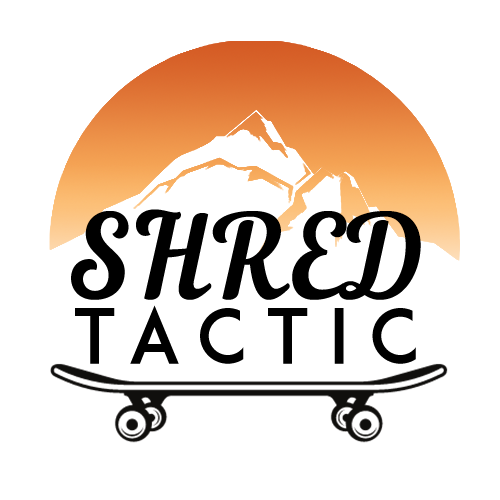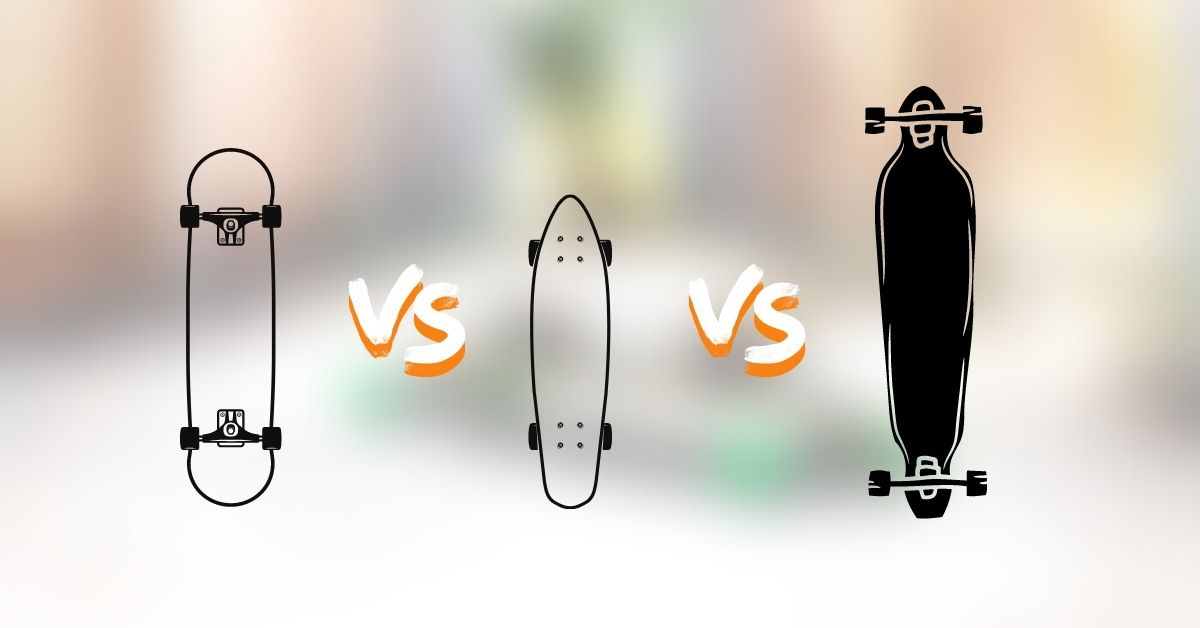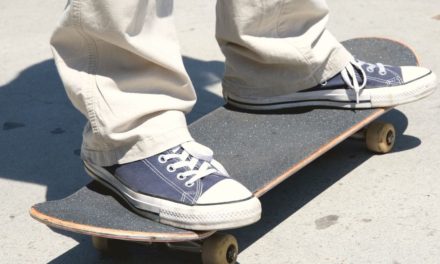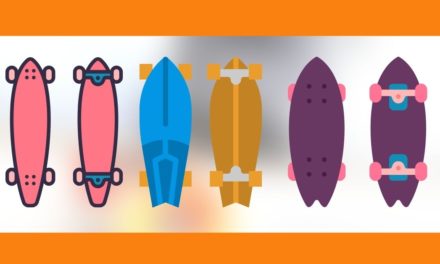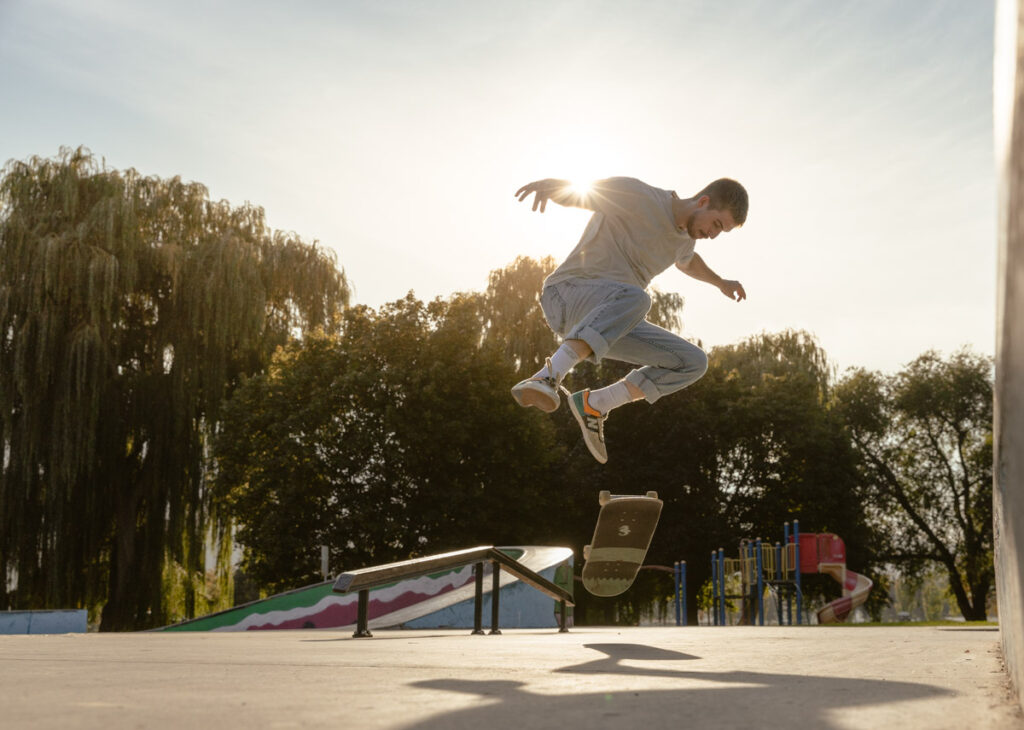Skateboards, longboards, and cruisers are the three main types of boards, but what’s the difference between them? Each of these boards is meant for a specific type of rider from their deck shape, wheel size, trucks, and uses. To make life easy, let’s first look at these differences at a glance.
| Features | Skateboards | Longboards | Cruisers |
|---|---|---|---|
| Deck Length | 31″ – 33″ | 35″ – 42″ | 22″ – 38″ |
| Deck Width | 7.5″ – 8.75″ | 8.5″ – 10.25″ | 8″ – 9.5″ |
| Wheel Size | 50mm – 55mm | 65mm – 75mm | 60mm – 65mm |
| Truck Size | 129mm – 159mm | 149mm – 215mm | 139mm – 169mm |
| Best For | Tricks, Skateparks, Street Skating | Hill Bombing, Cruising, Sliding | Transporation |
With these basic differences in mind, let’s take a deeper look at skateboards, longboards, and cruisers to find out which one is best suited for you.
Skateboards Explained
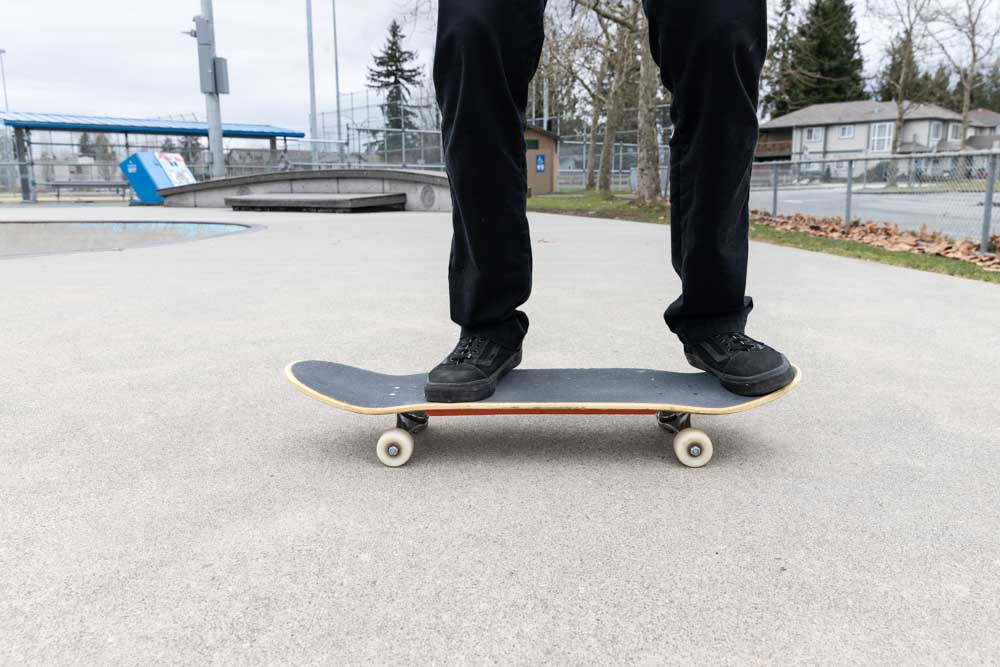
Skateboards are typically symmetrical with upturn kicks on the nose and tail. These are used to help lift and turn the board or pop tricks. Skateboards are one of the most versatile types of boards since they can be used for tricks, ridden in bowls, taken around town, and are fun to ride regardless of your abilities.
The average length of a skateboard is 32″; however, this varies based on the width of the deck. Most skateboards range in width from 7.5″ to 8.75″ to suit different sizes of skaters and skating styles. For example, a narrow deck would be better if you have small feet or want a board that’s easier to flick.
I personally skate decks in the range of 8.25″ – 8.5″ since I find it most comfortable being over 6ft tall with a size US 10.5 shoes. The width of the deck you skate on ultimately depends on personal preference.
As for trucks, skateboard trucks have a hanger width based on the width of the deck, with the kingpin facing the center of the board. The wheels sizes for most skateboards range between 50mm – 55mm since you can fit the wheels without needing a riser pad.
Since skateboards are typically used for tricks, the wheels are usually harder, allowing for easier sliding, pivoting out of tricks, and reduced rolling resistance. Although these hard wheels aren’t as smooth to ride on rough roads, they perform far better on smooth surfaces like at the skatepark than a softer wheel.
Longboards Explained
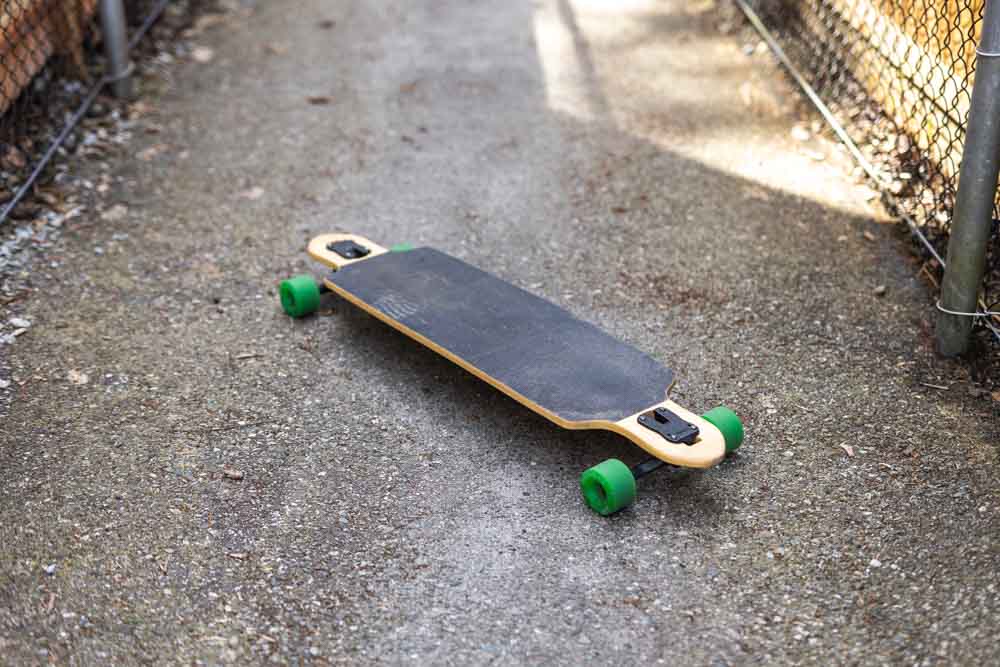
Longboards have a completely different shape than skateboards, going up to 42″ in length, with various deck shapes depending on the style of longboarding you want to do.
Longboard decks come in a variety of stiffnesses that allow the deck to bend and absorb bumps as you ride. Mixed with the extra soft wheels most longboards have, you find yourself with the ultimate in smooth riding, even on bumpy roads.
Since many longboard shapes have wheel wells or cutouts to fit larger wheels, these boards have an average wheel diameter of 65mm – 75mm+. These larger wheel diameters help longboards hold speed exceptionally well compared to a standard skateboard wheel.
As for trucks, longboard trucks have a steeper pivot angle, making them better for carving and tight turns. The width of the trucks once again depends on the width of the deck you’re riding.
Unlike skateboards which can be used for just about anything, different longboard shapes have different purposes. For example, if you want to cruise around town or carve through your neighborhood, you’ll look for a different deck shape than someone who wants to bomb hills.
At the most basic level, there are two types of longboards known as directional or twin/symmetrical shapes. Directional longboards have a different shape between the nose and tail and are meant to be ridden in one direction only. Twin decks are the opposite, with symmetrical shapes on either end of the deck, giving the board the same feel regardless of which direction you ride it.
Directional boards are more common for people who just want to cruise and carve on their longboard, while symmetrical decks are favorable for those who want to do slides.
Longboard Deck Styles
Besides the directional or twin shape, there are other factors to consider based on how the trucks are mounted to the deck. Here are the different types of longboard decks summarized:
– Top Mount
Top mount decks have the trucks mounted directly beneath the longboard, similar to a skateboard. These decks have a higher center of gravity, making them easily maneuverable and snappy to ride. They are great for cruising and carving but can feel wobbly for beginners
– Drop Through
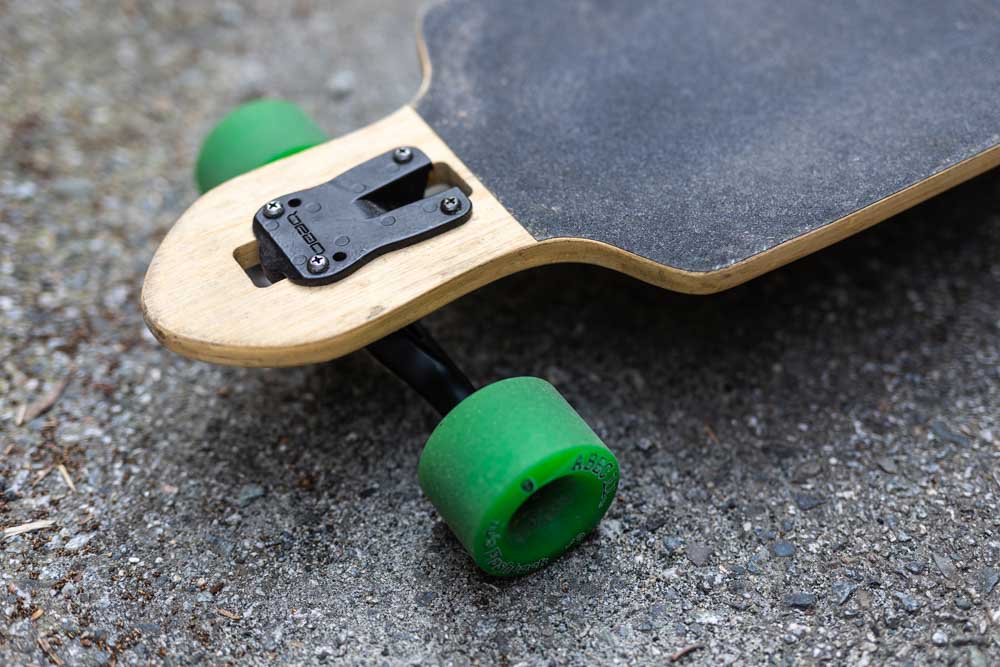
Drop through decks have trucks that mount through the nose and tail of the longboard. This lowers the riding height of the deck and makes it feel more stable than a top mount. Drop through decks are great for all types of longboarding, from casual cruising to bombing hills.
– Drop Deck
Drop decks have a lifted front and back where the trucks mount, so where you stand is actually below your trucks. This unique shape makes it easier to push and stop the board. However, the shape limits how hard you can turn, and is more difficult to slide since it’s so close to the ground. These are most commonly used as downhill boards but can still be used for cruising.
– Double Drop
Double drop decks mix a drop deck shape with a drop through truck mount. This makes you as low as possible to the ground, making them the most stable compared to any other deck. With that said, this extra-low riding height makes it more challenging to maneuver the board, so these are most often used as downhill-specific boards.
Cruiser Boards Explained
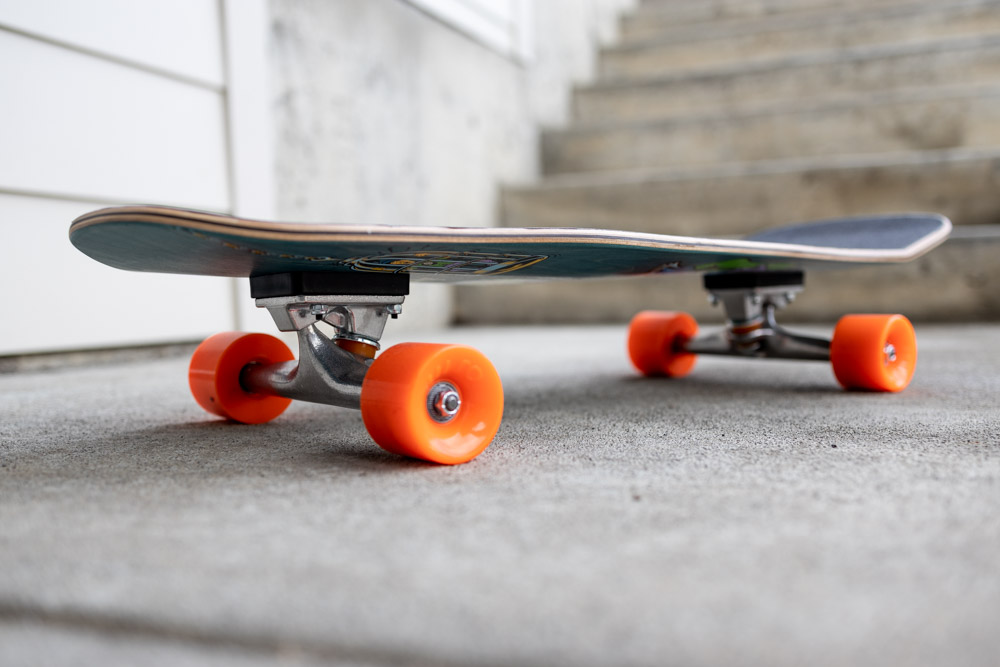
Cruiser boards are like a hybrid between a skateboard and a longboard. They have a somewhat similar size to a standard skateboard, with a length up to 38″ and a width starting at 8.5″. They differ in the board shape, which is usually directional for most cruiser decks. That means they’re only meant to be ridden in one direction, usually with an upturned tail and a flat or pointed nose.
Cruiser decks get their names because they are one of the best options for cruising around town. With the softest wheels of all compared to skateboards and longboards, these boards float over chunky roads like nothing. However, since they aren’t necessarily designed for tricks or bombing hills, they can get away with an uber-soft wheel to make for a comfort-focused ride.
Cruisers also have larger wheels than your standard skateboard since you can add large risers. Since tricks aren’t a priority on a cruiser board, you can add 1/2″ risers without losing out on board feel. With risers, your deck is mounted further away from your trucks, creating more room for a larger wheel. The most common wheel size for cruisers is 60mm, but this can go up if you have larger risers or your deck has wheel wells.
Finally, cruiser boards use the same trucks as a standard skateboard, but they often require a larger truck width since the decks are wider.
Ultimately cruiser decks are meant for getting around town as comfortably and as easily as possible. Since they are easier to carry and transport than a longboard but smoother and more comfortable than a skateboard, they are the perfect in-between option.
Wheel Comparison Between Skateboards, Cruisers, And Longboards
When comparing the different wheels between skateboards, cruisers, and longboards, the two primary differences are wheel diameter and wheel hardness.
– Wheel Diameter (Size)
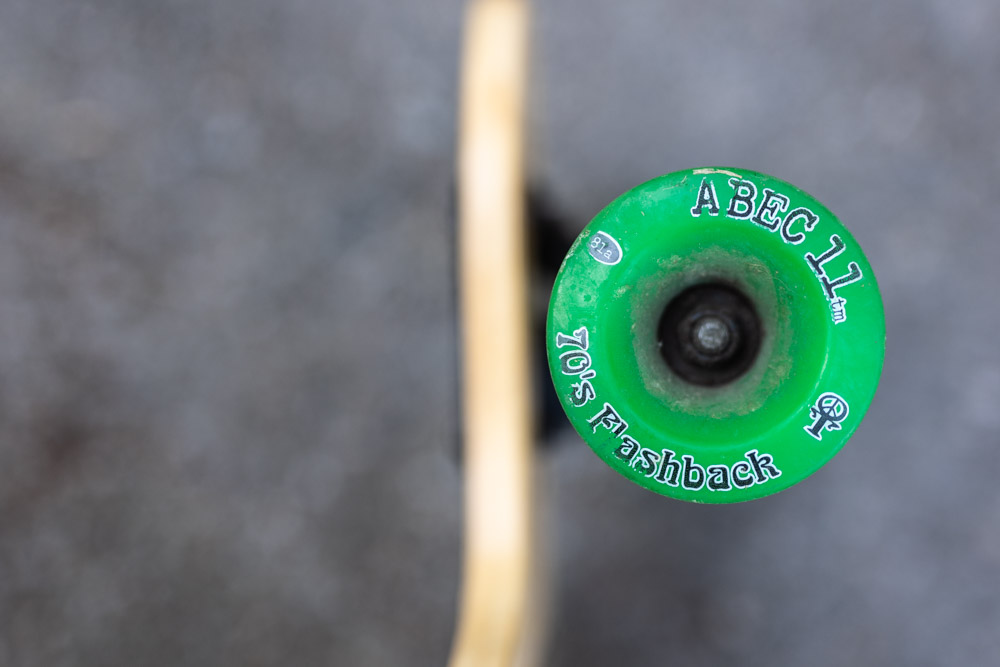
It’s important to note that a larger diameter wheel accelerates slower but holds speed exceptionally well. A smaller diameter wheel is the opposite, with much faster acceleration but a slower top speed.
This is why longboards and cruisers often have larger wheels since they are focused on rolling long distances, holding speed, and going fast. With the larger diameter wheel, this is much easier to do.
On the other hand, skateboards have smaller wheels since speed isn’t necessarily the number one priority. Instead, runups to a feature are limited, and you want to get up to speed as fast as possible. Therefore, a smaller wheel proves more useful for this type of board.
– Wheel Durometer (Hardness)
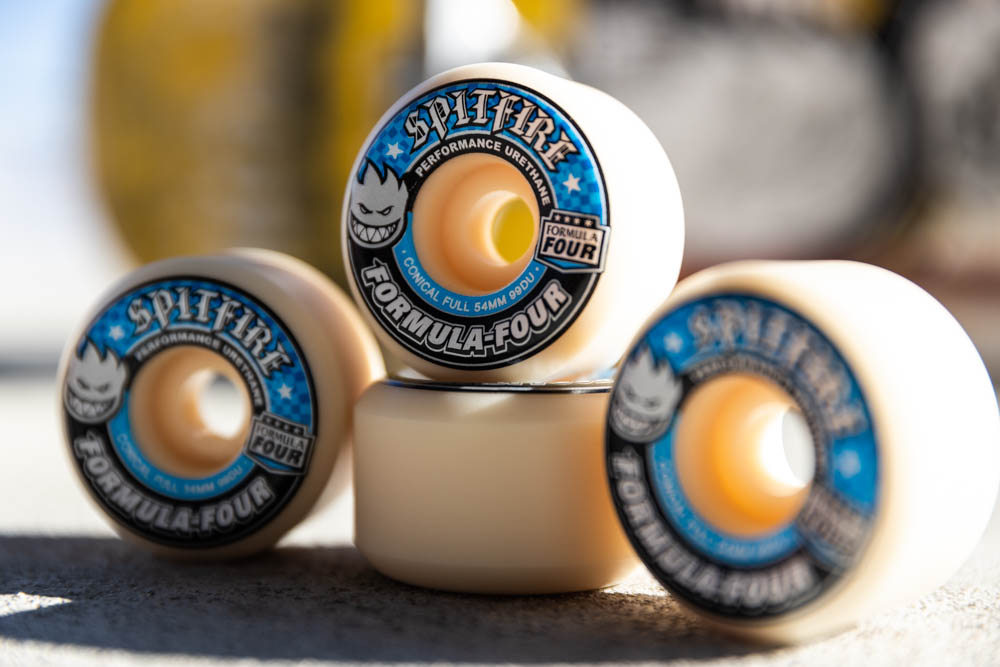
Now wheel hardness controls both the grip, ride feel, and speed of the wheel. A softer wheel offers a better grip and a smoother ride since it absorbs the vibrations from the ground. The downside to softer wheels is that they don’t hold speed as well since their softness absorbs your momentum. An easy way to think of this is like riding a bike with a flat tire compared to a well-inflated one.
A harder wheel durometer gives the opposite experience of a soft wheel, with more vibrations, less grip, and a faster top speed.
Most longboards and cruisers have softer wheel durometers, ranging from 78a to 87a, while most skateboard wheels are 97a – 101a. I get into the differences between soft and hard wheels more in-depth here.
Longboarders who are more downhill-specific and do slides opt for a harder wheel such as 87a because it rolls faster and slides easier. Meanwhile, casual longboarders and cruiser board riders go for a softer wheel like 78a because it absorbs more bumps in the cement to create a smoother ride.
As for skateboards, they use a harder wheel durometer to allow for better speeds on smooth concrete (like the skatepark) and less resistance when pivoting out of tricks. Skaters who only skate at skateparks or indoor facilities usually skate harder wheels 99a – 104a since they are easy to slide and maneuver.
However, skaters who skate in the streets on rough roads tend to use a slightly softer wheel like 95a – 97a to give a slightly smoother ride without sacrificing too much for sliding or pivoting out of tricks.
Truck Comparison Between Skateboards, Cruisers, And Longboards
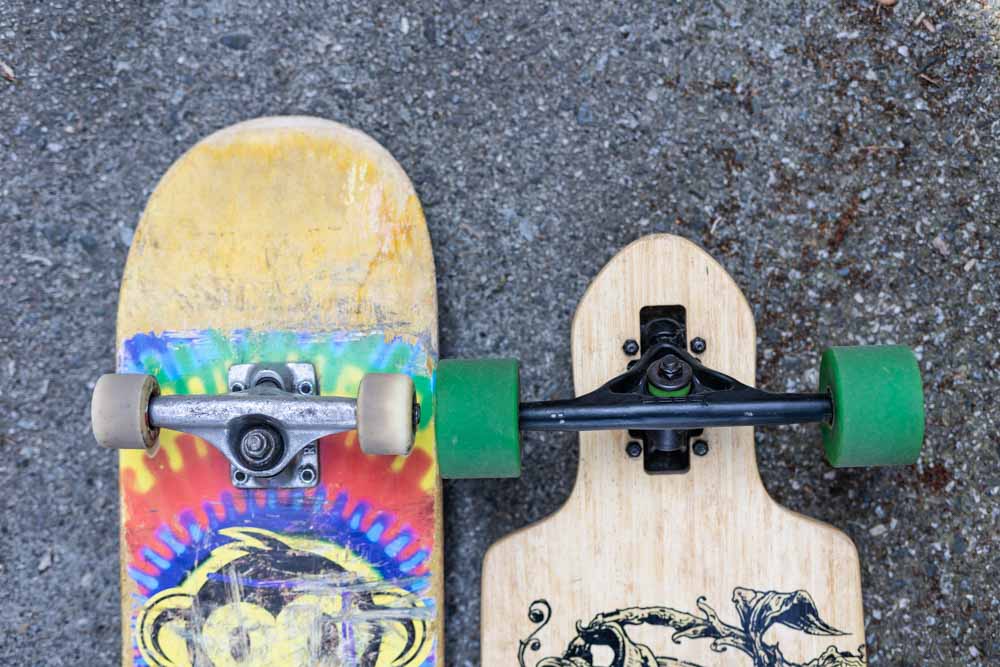
The basic anatomy of trucks used for all three of these boards is essentially the same. You have a base plate to attach your trucks to the deck, a hanger and axle to hold your wheels and pivot the trucks, a kingpin to hold your hanger and bushings in place, and bushing to control the stiffness of your trucks as you turn.
The difference, however, is that longboard trucks have the kingpin pointed outwards, while skateboard and cruiser trucks have a kingpin that points inward towards the middle of the board.
Longboard trucks also have different geometry regarding the angle the hanger extends from the pivot cup. This steeper angle makes it easier to turn and control your board at high speeds.
Meanwhile, skateboard and cruiser trucks (which are the same) have a lessened pivot angle which changes the feel of turning. Although it is different, it’s still easy to turn and maneuver a skateboard or cruiser by leaning from side to side. It just feels a little less tactile than a longboard truck.
Before you think you can interchange longboard trucks and skateboard/cruiser trucks, remember it doesn’t work that way. Putting skateboard trucks on a longboard wouldn’t work because of the deck styles and would make for a wobbly ride. The same thing applies if you put longboard trucks on a skateboard deck.
Skateboards vs. Longboards vs. Cruisers – What’s Easiest To Learn?
Although these boards are essentially the same to balance, turn, push, and stop with, longboards tend to be the easiest to learn on.
Since they are both longer and wider, they provide a more solid platform to stand on without feeling wobbly. This isn’t necessarily true for all types of longboard deck styles, but more applies to drop through and drop deck longboards. With a larger size and a lower center of gravity, these longboards feel less wobbly to stand on and are more confidence-inspiring as you gain speed.
With that said, there’s not such a difference in learning on one board in terms of how long it will take you to get comfortable. Although the first day on a longboard may be a bit easier, starting on a skateboard or cruiser board is largely the same. The only difference is that they may feel more wobbly upon first impressions.
Just because a longboard feels more stable doesn’t mean that’s the board you should start with. Instead, you need to ask yourself what type of rider you are.
How To Know Which Type Of Board Is Best For You

As you’ve learned so far, skateboards, longboards, and cruisers all serve different purposes.
Skateboards are great for doing tricks and riding bowls but can even be taken around town.
Longboards are great for carving, sliding, or bombing hills but are limited with tricks compared to a skateboard.
Meanwhile, a cruiser board is great for taking around town, carving through your neighborhood, or even rolling around the skatepark.
So to know exactly which board is right for you, you need to think of what you want to get out of your board.
If you:
- Want to learn flat ground tricks
- Want to skate bowls and transition
- Want to learn grinds on rails and ledges
- Want a general-purpose board that can “do it all”
Then a skateboard is best for you.
If you:
- Want to go as fast as possible
- Want to bomb hills
- Want to practice slides
- Want to carve downhill
- Want the most smooth and balanced ride
Then a longboard will be more your style.
If you:
- Want a board to ride around town with
- Want a board to commute with
- Want a board that’s fun to carve anywhere
- Want a board you can still roll around the skatepark with
Then go for a cruiser board.
With all the differences between skateboards, longboards, and cruisers aside, the main one to focus on is the experience they give you. Depending on what you want to get out of the board, that will answer which one is best for you.
And if you are still struggling to decide, there’s no harm in getting more than one. 😉
Happy Shredding!
Brendan 🙂
